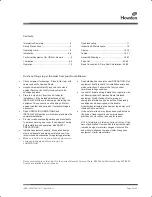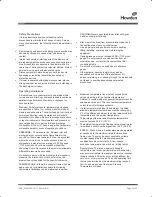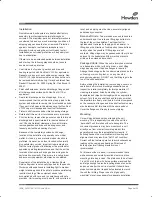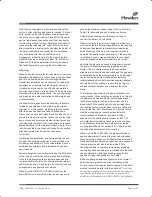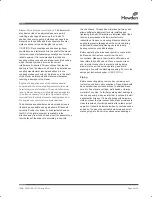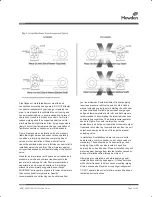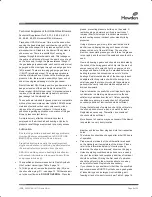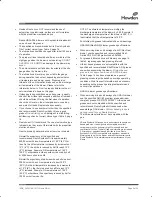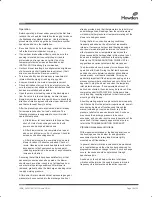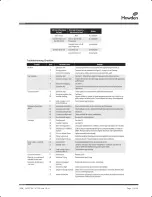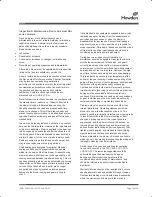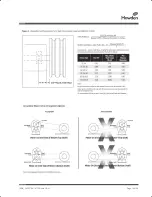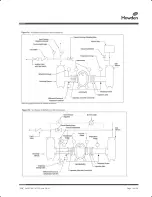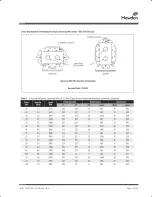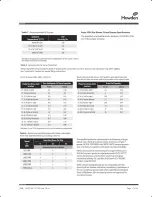
ISRB_2002 GEA 19171 Roots URAI
Page 3 of 32
Safety Precautions
It is important that all personnel observe safety
precautions to minimize the chances of injury. Among
many considerations, the following should be particularly
noted:
Blower casing and associated piping or accessories may
become hot enough to cause major skin burns on
contact.
Internal and external rotating parts of the blower and
driving equipment can produce serious physical injuries.
Do not reach into any opening in the blower while it is
operating, or while subject to accidental starting. Protect
external moving parts with adequate guards.
Disconnect power before doing any work, and avoid
bypassing or rendering inoperative any safety or
protective devices.
If blower is operated with piping disconnected, place a
strong coarse screen over the inlet and avoid standing in
the discharge air stream.
CAUTION: Never cover the blower inlet with your
hand or other part of body.
Stay clear of the blast from pressure relief valves and
the suction area of vacuum relief valves.
Use proper care and good procedures in handling,
lifting, installing, operating and maintaining the
equipment.
Casing pressure must not exceed 25 PSI (1725 mbar)
gauge. Do not pressurize vented cavities from an
external source, nor restrict the vents without first
consulting Roots.
Do not use air blowers on explosive or hazardous
gases.
Other potential hazards to safety may also be
associated with operation of this equipment. All
personnel working in or passing through the area should
be trained to exercise adequate general safety
precautions.
Operating Limitations
A Roots blower or exhauster must be operated within
certain approved limiting conditions to enable continued
satisfactory performance. Warranty is contingent on
such operation.
Maximum limits for pressure, temperature and speed
are specified in Table 1 for various models & sizes of
blowers and exhausters. These limits apply to all units of
normal construction, when operated under standard
atmospheric conditions. Be sure to arrange connections
or taps for instruments, thermometers and pressure or
vacuum gauges at or near the inlet and discharge
connections of the unit. These, along with a tachometer,
will enable periodic checks of operating conditions.
PRESSURE
– The pressure rise, between inlet and
discharge, must not exceed the figure listed for the
specific unit frame size concerned. Also, in any system
where the unit inlet is at a positive pressure above
atmosphere a maximum case rating of 25 PSI gauge
(1725 mbar) should not be exceeded without first
consulting Roots. Never should the maximum allowable
differential pressure be exceeded.
On vacuum service, with the discharge to atmospheric
pressure, the inlet suction or vacuum must not be
greater than values listed for the specific frame size.
TEMPERATURE
– Blower & exhauster frame sizes are
approved only for installations where the following
temperature limitations can be maintained in service:
Measured temperature rise must not exceed listed
values when the inlet is at ambient temperature.
Ambient is considered as the general temperature of the
space around the unit. This is not outdoor temperature
unless the unit is installed outdoors.
If inlet temperature is higher than ambient, the listed
allowable temperature rise values must be reduced by
2/3 of the difference between the actual measured inlet
temperature and the ambient temperature.
The average of the inlet and discharge temperature
must not exceed 250°F. (121°C).
The ambient temperature of the space the blower/motor
is installed in should not be higher than 120°F (48.8°C).
SPEED
– These blowers & exhausters may be operated
at speeds up to the maximum listed for the various
frame sizes. They may be direct coupled to suitable
constant speed drivers if pressure/temperature
conditions are also within limits. At low speeds,
excessive temperature rise may be a limiting factor
Special Note:
The listed maximum allowable
temperature rise for any particular blower & exhauster
may occur well before its maximum pressure or vacuum
rating is reached. This may occur at high altitude, low
vacuum or at very low speed. The units’ operating limit
is always determined by the maximum rating reached
first. It can be any one of the three: Pressure,
Temperature or Speed.
ISRB_2002 GEA 19171 Roots URAI.indd 3
17/09/2015 12:52
Summary of Contents for Roots Metric Series
Page 11: ...ISRB_2002 GEA 19171 Roots URAI Page 11 of 32...
Page 13: ...ISRB_2002 GEA 19171 Roots URAI Page 13 of 32...
Page 14: ...ISRB_2002 GEA 19171 Roots URAI Page 14 of 32...
Page 15: ...ISRB_2002 GEA 19171 Roots URAI Page 15 of 32...
Page 16: ...ISRB_2002 GEA 19171 Roots URAI Page 16 of 32...
Page 17: ...ISRB_2002 GEA 19171 Roots URAI Page 17 of 32...
Page 18: ...ISRB_2002 GEA 19171 Roots URAI Page 18 of 32...
Page 19: ...ISRB_2002 GEA 19171 Roots URAI Page 19 of 32...
Page 20: ...ISRB_2002 GEA 19171 Roots URAI Page 20 of 32...
Page 21: ...ISRB_2002 GEA 19171 Roots URAI Page 21 of 32...
Page 22: ...ISRB_2002 GEA 19171 Roots URAI Page 22 of 32...
Page 23: ...ISRB_2002 GEA 19171 Roots URAI Page 23 of 32...
Page 24: ...ISRB_2002 GEA 19171 Roots URAI Page 24 of 32...
Page 25: ...ISRB_2002 GEA 19171 Roots URAI Page 25 of 32...
Page 26: ...ISRB_2002 GEA 19171 Roots URAI Page 26 of 32...
Page 27: ...ISRB_2002 GEA 19171 Roots URAI Page 27 of 32...
Page 28: ...ISRB_2002 GEA 19171 Roots URAI Page 28 of 32...
Page 29: ...ISRB_2002 GEA 19171 Roots URAI Page 29 of 32...
Page 30: ...ISRB_2002 GEA 19171 Roots URAI Page 30 of 32...


